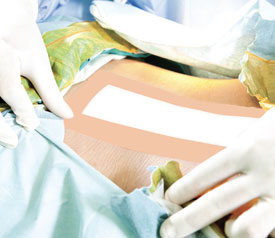
Factors affecting dressing application for the prevention of infection
Preventing wound infection is critical to ensuring rapid healing, patient comfort and the prevention of complication. The effects of infections can range from mild, to serious. Pain, odor, delayed healing, sepsis and even death are frequently associated with their incidence. Infection control starts by properly caring for the wound and following best practices. Nurses and healthcare providers can help avoid infection related complications. One of the most important components of effective infection management in wound care is wound dressing. Secure, gentle wound dressings that prevent leakage and the application of single use tape can help reduce the risk of infection and prevent more serious complications. [1] [2] [3]
This infection control guide will provide a brief overview of best practice guidelines for ensuring that wound dressings minimize a patient’s risk for infection.
Why infection control is critical to wound care
Infection management and prevention is one of the most important objectives of effective wound care. Infections can significantly add to the costs of wound care, cause patient discomfort and lead to more serious complications. This makes it extremely important that healthcare providers implement practices that reduce the risk of infection. [2] [3]
Infections are frequent – Even after clean surgery, studies find that the rate of wound infection is 8% in the general population and rises to 25% in elderly patients. [4] This rate likely rises further when wounds occur outside of controlled environments or the application of wound dressings are delayed. This makes wound infections one of the most common complications associated with wounds.
Infections can lead to more serious complications – Infections can lead to a wide range of more serious complications that can cause severe discomfort, impair the wound healing process and, if left untreated, can lead to injury or death. The most common complication associated with infection is inflammation, which can cause pain and discomfort for patients. Caregivers should also pay careful attention to signs of sepsis such as increased body temperature, abnormally high heart rate and difficulty breathing. This can eventually lead to severe sepsis and septic shock, which can cause low blood pressure, putting the patient at great risk. More serious complications are particularly common in the elderly, the very young, those with other health condition and those with severe wounds. [5]
Infections delay wound healing and increase costs – Infections can significantly delay wound healing by impairing the body’s natural healing process. They can also increase the costs associated with wound care because they require additional treatment and attention from healthcare professionals. Recent studies show that the average infection costs hospitals an additional $6,813, dramatically increasing the overall cost of wound treatment. [6]
Best wound dressing practices for preventing infection
Given the costs and complications associated with wound infections, it is extremely important that nurses and other healthcare professionals take steps to reduce their incidence and minimize their impact on patient health. This section will outline several wound dressing best practices that help reduce the risk of infection and cross contamination.
Why effective wound dressing is important
Wounds need a moist healing environment with protection from outside pathogens to heal rapidly and with minimal risk of complication. Effectively dressed wounds can help prevent infection by blocking foreign matter and ensuring an ideal wound environment. This is particularly important when the wound is at greater risk of exposure to potentially infectious substances, such as in those suffering from incontinence.
Wound dressing best practices
In order to provide an ideal healing environment, dressing should be strong, waterproof and gentle. This allows them to protect the wound from potentially infectious pathogens while creating the best possible conditions for rapid and complete healing. [1] [2] [3]
Dressings should be secure – Dressings must be secured with a powerful adhesive in order to prevent looseness that can allow material to enter the wound area. This also can reduce the frequency with which dressings need to be replaced, reducing exposure to foreign material. [2]
Dressings should be gentle – The removal of dressings often exacerbates wound inflammation and can cause skin tearing. Dressing adhesives should be gentle to prevent irritation or more serious injury that might delay wound healing or make the wound more susceptible to infection. [2] [3]
Dressings should be waterproof – Wound dressings are often exposed to sweat, incontinence or other sources of moisture that can weaken the adhesive and cause the dressing to fall off. Dressing adhesives should be waterproof to prevent this from occurring, particularly in active patients or those suffering from incontinence. [2] [3]
Dressings should reduce the risk of cross contamination – One of the major sources of infection is contamination from healthcare providers or other patients. This is exacerbated when a single roll of medical adhesive is shared among multiple patients. When tape is hygienically sealed and used only for a single patient, it is possible to avoid these issues. However, keeping a single roll for a single patient is often more costly and less practical. Using tape in short roles and single use packaging can help reduce costs, reduce tape waste and lower the risk of cross contamination. [7]
– – – – – – – – – – – – – – – – – – – – – – – – – – – – – – – – – – – – – – – – – – – – – – – – – – – – – – – – – – – – – – – – – – – – – – – – – – – – – – – – – – – – – – – –
Conclusions
Effective wound dressing is the first line of defense against infection. It helps provide an environment free from pathogens in which the wound can heal rapidly and without complications. By following wound dressing best practices and using a strong, gentle and waterproof medical adhesive, nurses and other healthcare professionals can help reduce the risk of infection and improve patient outcomes.
How Hy-Tape products can help with infection control
Hy-Tape makes a range of medical adhesive products available in single use packaging and short rolls that are secure, gentle, and effective. Hy-tape strips, patches, and kit rolls provide a wide range of options for securing dressings in unusual positions. Hy-tape products are strong, gentle, and effective, allowing them to firmly hold a dressing in place, no matter the location. By framing dressings with Hy-Tape, you can reduce the risk of peeling corners and create a longer lasting dressing that will stay on for the entirety of the prescribed time. Hy-tape products are also nurse approved. In a recent study involving patients with Stage II, III, and III pressure sores treated with a hydrocolloid dressing secured by Hy-Tape, Hy-tape was 8given an “Excellent” rating by healthcare practitioners. [7]
Purchase Hy-Tape single use tape rolls – Available in half inch and one Inch.
Infection Control References:
[1] Ubbink DT, Brölmann FE, Go PMNYH, Vermeulen H. Evidence-Based Care of Acute Wounds: A Perspective. Advances in Wound Care. 2015;4(5):286-294. doi:10.1089/wound.2014.0592.
[2]HSE Office of the Nursing Services Director. National best practice and evidence based guidelines for wound management.
[3] Guo S, DiPietro LA. Factors Affecting Wound Healing. Journal of Dental Research. 2010;89(3):219-229. doi:10.1177/0022034509359125.
[4] Noman TA, Raja’a YA, Assiraji HM, Assofi YA. Rate of wound infection after clean surgery. Saudi Med J. 2001;22(1):58-60.
[5] Longo DL, et al., eds. Severe sepsis and septic shock. In: Harrison’s Principles of Internal Medicine. 19th ed. New York, N.Y.: McGraw-Hill Education; 2015. http://accessmedicine.com. Accessed Nov. 23, 2015.
[6] Drew P, Posnett J, Rusling L, on behalf of the Wound Care Audit Team. The cost of wound care for a local population in England. Int Wound J 2007;4:149-155.
[7] Single-Patient Rolls of Medical Tapes Reduce Cross-Contamination Risk. Infection Control Today. http://www.infectioncontroltoday.com/articles/2013/01/singlepatient-rolls-of-medical-tapes-reduce-crosscontamination-risk.aspx. Published January 21, 2013. Accessed August 8, 2017
[8] Case Studies for Ostomy/Wound Care. Case Studies for Ostomy/Wound Care.

